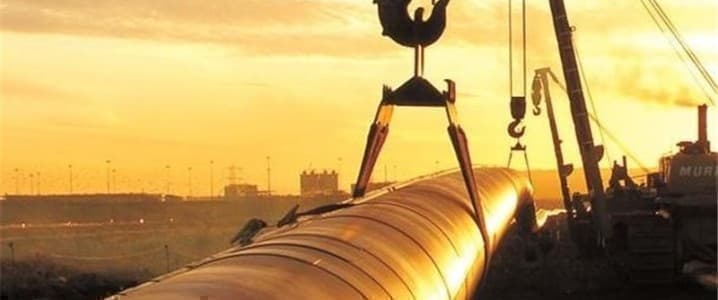In its latest biennial assessment delivered last week, the Potential Gas Committee (PGC) reported that U.S. natural gas supply has hit a record 3,978 trillion cubic feet, good for a 3.6% increase from the 2020 estimate with shale gas dominating supply at 61%. The country’s technically recoverable resources, however, fell slightly by 0.5% to 3,352 Tcf likely due to some volumes being shifted to other categories. The Atlantic region, home to the gas powerhouse Marcellus and Utica shale plays, harbors the lion’s share of supplies at 40% of estimated gas resources. More than 800 volunteer geoscientists and engineers contributed to PGC’s assessments.
Unfortunately, unlocking that deluge of gas might be limited by the availability of one critical infrastructure: gas pipelines.
"Future gas supplies continue to increase as the energy industry innovates, improves processes, optimizes resources, invests in efficiency and reduces emissions. However, to fully realize the potential of this natural gas supply, new infrastructure will be required to connect production zones to demand centers,” Richard Meyer, the American Gas Association's vice president of energy markets, analysis and standards, has said.
It’s a viewpoint buttressed by PGC President Kristin Carter, “The availability of pipelines to get the product out of the shale gas fields in particular--there's only so much they can get to market without more of that infrastructure. So for that reason, you might have inactive wells."
‘Pipeline constraints’ is becoming an increasingly common refrain. Over the years, environmental groups In the Appalachian Basin, the country’s largest gas-producing region churning out more than 35 Bcf/d, have repeatedly stopped or slowed down pipeline projects. This has left the Permian Basin and Haynesville Shale as the regions doing much of the heavy lifting when it comes to growing LNG exports. Indeed, last year, EQT Corp.(NYSE: EQT) CEO Toby Rice acknowledged that Appalachian pipeline capacity has “hit a wall.”
Analysts at East Daley Capital Inc. have projected that U.S. LNG exports will double by 2030 from their current level of ~13 Bcf/d. But for this to happen, the analysts estimate that another 2-4 Bcf/d of takeaway capacity needs to come online between 2026 and 2030 in the Haynesville.
“This assumes significant gas growth from the Permian and other associated gas plays. Any view where oil prices take enough of a dip to slow that activity in the Permian and you’re going to have even more of a call for gas from gassier basins,” the analysts have said.
LNG Expansion
The construction of new export terminals has rapidly increased U.S. LNG exports every year since 2016, making the country one of the top three LNG-exporting countries in the world. The U.S. Energy Information Administration (EIA) has forecast that U.S. LNG exports will continue to grow in 2024, as two LNG projects come online: Golden Pass in Texas and Plaquemines in Louisiana.
Golden Pass Trains 1 and 2 projects is a joint venture between ExxonMobil Corp.(NYSE:XOM) and QatarGas. They are being built at an existing LNG import terminal in Texas that will be converted into an LNG export facility consisting of three trains, each with 0.68 Bcf/d of nominal capacity, or 0.80 Bcf/d of peak capacity. According to filings with the Federal Energy Regulatory Commission (FERC), Trains 1 and 2 will come into service during the second and fourth quarters of 2024, respectively while Train 3 will come online in the first quarter of 2025.
Meanwhile, Plaquemines LNG Phase 1 is a Venture Global project located in Louisiana. Phase 1 consists of 9 blocks, each containing 2 liquefaction trains for a total of 18 liquefaction trains with a combined nominal capacity of 1.3 Bcf/d, or peak capacity of 1.6 Bcf/d. According to FERC filings, developers plan to bring Phase 1 online by the end of 2024 and expect to start LNG production in August 2024. EIA has projected that Golden Pass Trains 1 and 2 and Plaquemines Phase 1 will add a total of 2.7 Bcf/d of nominal LNG export capacity, or 3.2 Bcf/d of peak capacity with nominal liquefaction capacity increasing to 14.1 Bcf/d and peak capacity to 17.0 Bcf/d across the nine U.S. LNG export facilities by the en
EIA notes that current international natural gas market conditions are conducive for expanding U.S. LNG exports, with natural gas prices in Europe and Asia relatively high compared with U.S. natural gas prices. Meanwhile, relatively little growth in global LNG export capacity is expected in the next two years thus increasing demand for flexible LNG supplies, mainly from the United States. The energy watchdog has estimated that U.S. LNG exports will average 12.0 billion cubic feet per day (Bcf/d) in the current year and increase to 13.3 Bcf/d in 2024. EIA has predicted that U.S. LNG exporters will use 105% of nominal capacity in 2023 and 108% in 2024, utilization levels equivalent to 88% and 90% of peak capacity in those years.
By Alex Kimani for Oilprice.com
More Top Reads From Oilprice.com:
- An Apparently Unstoppable Oil Price Rally
- Chevron LNG Plant Returns To Full Production As Strikes Continue
- Hedge Fund Partner Blasts Oil Demand Decline Narrative


















